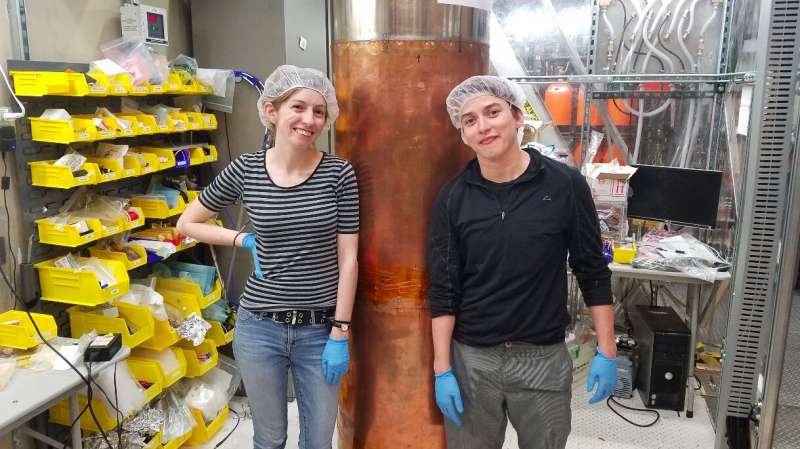March 31, 2020 feature
A new search for axion dark matter rules out past numerical predictions

The ADMX collaboration, a group of researchers working at universities across the U.S. and Europe, has recently performed a new search for invisible axion dark matter using a cavity haloscope and a low-noise Josephson parametric amplifier. Cavity haloscopes are sensitive instruments designed to detect and study halos around luminous bodies or other physical phenomena. Josephson parametric amplifiers, on the other hand, are technological tools that can be used to manipulate quantum states of microwave light fields.
In their recent paper, published in Physical Review Letters, the researchers searched for dark matter axions in the galactic halo with a mass ranging between 2.81–3.31 μeV. The results of this search could help to rule out previous theoretical predictions, informing the future search for invisible axion dark matter.
"Our recent search was motivated by two different mysteries in physics, both of which would be solved with the detection of axion dark matter," Nick Du, researcher at the University of Washington and co-author of the recent paper, told Phys.org. "The first of these is the dark matter mystery."
Past physics studies have found evidence that what we ordinarily think of as matter only makes up approximately 15% of the total mass of the universe. The remaining 85% is thought to be composed of particles that do not absorb, emit or reflect light, and thus cannot be detected using traditional techniques for studying matter.
This non-luminous material, known as dark matter, remains one of the greatest mysteries in contemporary physics, as researchers are still unsure about whether it exists and what it is made of. While there have now been countless searches for dark matter using a variety of instruments, this mysterious material has so far never been observed or detected.

"One possible solution to what dark matter could be comes from another field of physics, namely nuclear physics, in the form of another mystery known as the Strong CP problem," Du explained. "A popular solution to the Strong CP problem predicts the existence of a new particle known as the axion, and the properties of the axion make it a compelling candidate for dark matter. In looking axion dark matter, the ADMX collaboration hopes to solve both the Strong CP problem and the mystery as to the nature of dark matter. "
The cavity haloscope used by Du and his colleagues consists of a resonant cavity placed inside of a large magnetic field. According to theoretical predictions, dark matter axions in the galactic halo should couple to the magnetic field in the cavity and produce photons.
The number of photons produced is likely to be very small, making the resulting signal very difficult to detect. By tuning the resonant cavity inside the axion haloscope to the same frequency as the photons, however, the number of photons produced by the galactic halo can be enhanced.

"In a way, our search for axion dark matter is quite similar to how a radio operates," Du said. "As the frequency of a radio is tuned, one can pick up on different radio stations. In that respect, our experiment is similar, except that we don't know the frequency of our radio station and the signal is much weaker."
The search for dark matter axions has been ongoing for several decades now, and Du and his colleagues have already carried out a number of such searches using their cavity haloscope. While they were so far unable to detect invisible axions, the results of their recent experiment rule out a range of axion masses that were previously predicted by benchmark theoretical models of axion dark matter.
"This is actually the second time our experiment has achieved this sensitivity to axion dark matter, but this time, we have tripled the range we covered in our previous study," Du said. "By achieving and expanding on this sensitivity, we've shown that in the continued search for axion dark matter, ADMX represents one of the best hopes for finding it."

The observations gathered by Du and his colleagues could inform future searches for dark matter axions, while also paving the way for novel theoretical predictions. The researchers are now conducting a new search for axion dark matter at higher frequencies. If this search is also unsuccessful, they plan to continue searching for invisible axions at even larger frequencies.
"At higher frequencies, axion dark matter becomes more difficult to detect, because the conventional cavities we would use are no longer as sensitive to axions," Du said. "However, we already have some interesting prototypes in place to get around this, such as experiments that use a multi-cavity array to search to axion dark matter."
More information: T. Braine et al. Extended Search for the Invisible Axion with the Axion Dark Matter Experiment, Physical Review Letters (2020). DOI: 10.1103/PhysRevLett.124.101303
N. Du et al. Search for Invisible Axion Dark Matter with the Axion Dark Matter Experiment, Physical Review Letters (2018). DOI: 10.1103/PhysRevLett.120.151301
Journal information: Physical Review Letters
© 2020 Science X Network





















